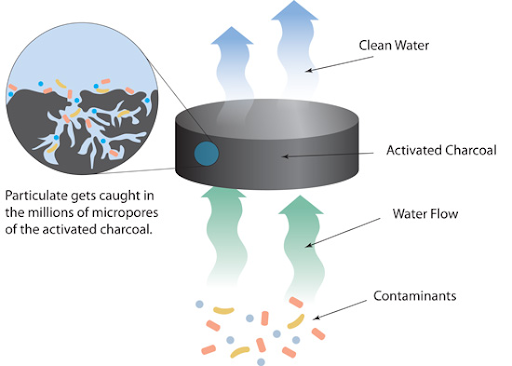In a recent national survey, experts estimate that 55% of Americans are concerned about the contaminants in their tap water. One way of mitigating this concern and protecting your family against harm caused by water pollutants is by installing a filtration system. Prevalent purification technologies that you can choose from, depending on your needs, are charcoal and GAC filters.
But how do these filtration technologies stack up against each other? And when should you choose GCA or charcoal filters for water purification? Find out more in this guide.
Table of Contents
Understanding Charcoal Filters
Also known as activated charcoal water filters, charcoal purifiers are one of the most widely used systems for trapping contaminants from tap or borehole water. Typically, they feature super-high adsorption capabilities derived from organic materials such as coconut shells. The filtration media can also be made of special coal, normally processed at high temperatures.
The primary function of the charcoal media in the filtration system is to get rid of impurities by adsorbing them. Typically, the media feature microscopic pores that provide a large surface area for the impurities to adhere to the activated carbon.
And thanks to this high-level purification technology, charcoal filtration media can effectively adsorb toxins, chemicals, and organic compounds. In addition to that, activated carbon for water filter can also help you get rid of unwanted elements in municipal tap water, including chlorine and fluoride.
Unveiling Granular Activated Carbon (GAC) Filters
Granular activated carbon (GAC) filters are relatively more advanced than their charcoal counterparts. Typically, GAC filters are common in point-of-entry faucets, especially if the filtration system targets whole-house use. By installing them at the point of entry, they ensure that all the other faucets in the house deliver purified water that is free of organic pollutants, as well as chlorine from city sources.
However, it’s important to note that these filtration media are often used alongside other filters, such as reverse osmosis (RO) membranes, especially for applications that want a comprehensive purification process that matches certain needs. When combined with other filtration media, the activated carbon for filter will purify water in different stages until all impurities are adsorbed.
At industry levels, these filtration media are used to adsorb volatile organic compounds (VOCs). VOCs are industrial solvents that contaminate water, such as trichloroethylene, and fuel oxygenates like methyl tert-butyl ether (MTBE).
Functions of Charcoal Filters and GAC Filters
While both charcoal and GCA filters serve nearly the same goal of removing impurities, their functions differ in several ways. For instance, charcoal filtration media works by adhering contaminants to the surface of the activated carbon particles. This happens through a scientific process known as adsorption, which targets mild contaminants, such as chlorine and fluoride.
On the other hand, GCA filtration media work by providing a higher flow rate for the incoming water. In return, this process targets harmful and larger particles, such as mercury or other heavy metals,
Key Differences between Charcoal Filters and GAC Filters
Structure and Form
Typically, charcoal filtration media feature finely ground activated carbon that offers a smooth texture to effectively adsorb impurities. On the other hand, the GAC features bigger activated carbon particles ground to resemble granules. For this reason, the charcoal in GAC filtration systems provides lower adsorption capacities than finely ground charcoal.
Filtration Capacity
It’s worth noting that both charcoal and GAC filters have varying filtration capacities, depending on a range of factors, including the size and type of contaminants involved. Nonetheless, charcoal is ideal for removing unpleasant odors and tastes, as well as chlorine. Contrastingly, the GAC filtration technique is a go-to option for removing heavy metals like mercury.
Lifespan and Maintenance
These water filtration media also differ in their lifespan. Typically, finely-ground charcoal granules can be replaced after about two to three months, depending on how often you use them, as well as the quality of unpurified water. On the other hand, GAC water filters can last up to 12 months before a replacement.
Choosing the Right Filter for Your Needs
Before choosing finely-ground or granular active carbon for water purification, it’s important to consider the type of contaminants that you’ll be targeting with the system. Other factors to consider include the ideal flow rate as well as the frequency of use.
If your goal is to purify tap water that is contaminated with chlorine, unpleasant order or VOCs, you might want to consider charcoal filters. But if you’re targeting highly toxic organic compounds and industrial effluents that may be present in your tap water, you should go for the alternative option, a granular activated carbon water filter.
Conclusion
While the choice of water purification technology ultimately depends on your budget and personal preference, both charcoal and GAC filtration techniques are ideal options. Activated carbon water treatment removes chlorine, VOCs, and mineral contaminants from your water, while GAC targets heavy metals such as mercury.





